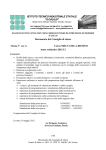Download SAFE Security Alarm System Owner`s manual
Transcript
Alarm System Operations Manual SAFE Security Alarm System Operations Manual SAFE SECURITY ALARM SYSTEM OPERATIONS MANUAL TABLE OF CONTENTS Welcome to SAFE ................................................................................................................................... 3 About SAFE ............................................................................................................................................. 4 SAFE Security Corporate Offices ............................................................................................................ 4 Billing and Payment Options ........................................................................................................ 5 How a Security System Works ............................................................................................................... 7 Alarm System Testing ............................................................................................................................ 9 Alarm System Maintenance ................................................................................................................ 10 False Alarms ......................................................................................................................................... 11 Frequently Asked Questions ................................................................................................................ 12 Also refer to the SAFE website at www.safesecurity.com for helpful information regarding general security, child safety, fire emergency and disaster preparedness. 2 www.safesecurity.com (800) 669-7779 SAFE Security Alarm System Operations Manual Welcome to SAFE Security® We are pleased to welcome you to the SAFE family of security alarm and monitoring services. Whether your security system has been recently installed by a SAFE authorized service dealer or you are already a security alarm system user and have come to us for monitoring and maintenance services, you can depend on SAFE for quality customer care, and regard us as your partner in system security for many years to come. Please review the information provided in this Alarm System Operations Manual as it contains important information about SAFE, plus the operation and general service of your security alarm system. Keep it handy for you will also find helpful information about your monitoring service, what to do about false alarms and who to call if your system needs service. Your account information may be accessed online at www.safesecurity.com or by calling our quality customer care representatives, who are technically knowledgeable about your security system. We thank you for entrusting the safety and security of your home, loved ones, and possibly your business to SAFE, where we regard your satisfaction as our highest priority. Sincerely, Paul Sargenti President and CEO SAFE Security® 3 www.safesecurity.com (800) 669-7779 SAFE Security Alarm System Operations Manual ABOUT SAFE SAFE has been providing security alarm monitoring and customer service since 1988. We are your alarm company and we are responsible for providing monitoring and service for your alarm system. If your system ever needs service, just call us at (800) 669-7779. If we can’t solve your issue over the telephone, we will dispatch a local, licensed security professional who is a member of our national network of SAFE Authorized Service Providers. We are here for you, 24 hours a day. SAFE SECURITY CORPORATE OFFICES SAFE Security 2440 Camino Ramon, Suite 200 PO Box 5164 San Ramon, CA 94583 Telephone: FAX: (800) 669-7779 (925) 830-5122 Please complete the information below for future use: Central Monitoring Station Telephone: ______________________________________________ Central Monitoring Station Account #: ______________________________________________ (identification number) SAFE Account #: _________________________________________________________________ (used for billing purposes) Alarm System Type: ______________________________________________________________ If you are not using SAFEPay, SAFE’s automatic withdrawal payment option, please send your payments to: SAFE Security PO Box 660826 Dallas, TX 75266-0826 To reach a SAFE customer care, service or sales representative during our office hours between 6:00 am and 5:00 pm, Pacific Time, call (800) 669-7779. Central monitoring station customer service operates 24 hours a day, seven days a week. For your convenience, please list your emergency contacts along with telephone numbers: Name Telephone ___________________________________________ ____________________________________ ___________________________________________ ____________________________________ ___________________________________________ ____________________________________ ___________________________________________ ____________________________________ ___________________________________________ ____________________________________ 4 www.safesecurity.com (800) 669-7779 SAFE Security Alarm System Operations Manual BILLING New customers: Starting with your next regular billing, SAFE will be invoicing your account. Please review the payment options below. At any time, if you wish to change to SAFEPay, our convenient automatic payment option, you may do so easily and securely online at www.safesecurity.com. If you have any questions when your statement arrives, please contact SAFE customer care at (800) 669-7779. Payments by check may be made to: SAFE Security PO Box 660826 Dallas, TX 75266-0826 PAYMENT OPTIONS Automatic Payments Savings account, checking account or credit card withdrawal: Your payments will be automatically transferred from your financial institution (bank) to SAFE depending on the billing date you selected. You will not receive a paper invoice from us. Each transaction will be recorded as a payment on your bank or credit card statement. If your payment date falls on a weekend or holiday, your card will be charged the next business day. You may also pay your bill online using your checking account or credit card at www.safesecurity.com/support/payment.html. Our “green” SAFEPay automatic payment option is the most convenient, saves time and money, and preserves environmental resources. We hope you will enjoy the convenience of SAFEPay. If you have questions regarding your payments to SAFE, call a SAFE customer care representative at (800) 669-7779. Rejected Payments Any check, automatic credit card or bank withdrawal payments that are rejected and returned will result in a $15 processing fee. To avoid additional processing charges, please ensure that we have a valid credit card or bank account number at all times. Billing Frequency SAFE can bill you on a monthly, quarterly, semi-annual or annual basis. We also offer SAFEPay. This convenient method of payment is drawn directly from your savings, checking account or credit card. Now you won’t have to hassle with writing out checks and getting your payment in on time. Billing Cycle All accounts are billed by the calendar month, in advance of service and due upon receipt. Account Numbers You actually have two account numbers, one for billing (used by SAFE to provide information on your account); the other is your central monitoring station identification number. 5 www.safesecurity.com (800) 669-7779 SAFE Security Alarm System Operations Manual BILLING (continued) Making a Payment Plan Change Although you may have selected a payment plan when you signed your monitoring agreement, you have the option of paying your monitoring fee annually, semi-annually, quarterly or monthly. Contact SAFE to change or to make special payment arrangements. Payments on First Statement Rarely, due to billing cycles, it is possible that your first bill was issued before your payment was posted. It may take one billing cycle for the posted payment to be reflected on your account. If your payment does not appear by the second billing cycle, please contact SAFE at (800) 669-7779 to verify that the payment was received. Payments by Check SAFE offers a variety of payment options. In fact, we highly encourage our popular and “green” SAFEPay paperless payment option which includes electronic funds transfer from your bank account, or auto-withdrawal from your VISA, MasterCard, Discover or American Express credit card. Billing Address Differs from Premise Address You may choose to have your bill sent to an address different from the alarm system location. Contact SAFE to let us know of a change in the billing address. 6 www.safesecurity.com (800) 669-7779 SAFE Security Alarm System Operations Manual HOW A SECURITY SYSTEM WORKS A SAFE security alarm system consists of a control panel which functions as a central computer, receiving messages from a number of sensors that act as the “eyes” and “ears” of the system. If the system is “armed” and the panel receives a signal from one or more of the sensors it automatically alerts the central monitoring station via a built-in telephone communicator and/or the option of a radio or cellular transmitter. The operator (or dispatcher) at the central monitoring station alerts the appropriate authorities, or others you designate, to the emergency situation. Keypads near common entry doors allow you to control the system. Any number of other alarm components or safety devices may make up a SAFE security system as noted below: Magnetic contacts to protect doors and windows that open Glass breakage sensors to protect glass windows and doors Motion sensors to detect movement within a defined area Panic switches that can be manually operated to summon the authorities and/or sound an alarm siren Window alarm screens which allow alarm protection with the windows open Sirens and sounders to alert you and your neighbors of alarm activation Smoke and heat detectors to alert you and the fire department of a fire Environmental sensors, such as freeze alarms, water leakage, and carbon monoxide detectors 24 HOUR MONITORING SERVICE Your SAFE alarm system is monitored by a central monitoring station There are many benefits to having a professionally monitored alarm system. The most obvious is the automatic reporting of unauthorized intrusions or smoke/fire. Your system is capable of notifying us of the type of alarm that is occurring; our trained operators will respond to each alert. Each alarm owner can dictate how we should respond and we will notify the police or fire authorities for you if required. The alarm system monitors its own system status and can alert us to maintenance and other issues that may require attention. Besides monitoring the status of the sensors and the control panel, it monitors the batteries and communications functions. What happens when the alarm goes off? When your system is being monitored and it goes into an alarm mode, it sends a signal to your central monitoring station. This signal tells us the type and location of the alarm. Depending on the type of signal, the central monitoring station staff will call the premises to determine if there is an emergency, call the appropriate support officials and then call you to inform you of the situation. Your have control in this process, as the specific procedures for this protocol are set up when your system is installed. Accidentally tripping the alarm First and foremost, remain calm. Simply enter your four-digit user code (and “OFF” on some systems). The system will send a cancellation signal to the central monitoring station. This verifies that an authorized user has disarmed the system and cancelled the alarm signal. If your system still doesn’t disarm, try your user code again. If you are unable to disarm, the central monitoring station will call shortly. Give them your password and indicate that you accidentally set off your alarm. Is there an automatic shut-off for the siren? Sirens can be programmed to sound for two or more minute increments. As most municipal ordinances require the outside alarm to cease after 15 minutes, many sirens are pre-set to sound off for 12 minutes. The siren time period is per occurrence and will re-sound if another violation is detected. If there is a break-in attempt, will the system re-arm? During an attempted break-in, the system will go into alarm and will remain armed until a user presses in his user code plus OFF. If there is subsequent detection, the system will go into alarm again. 7 www.safesecurity.com (800) 669-7779 SAFE Security Alarm System Operations Manual HOW A SECURITY SYSTEM WORKS (continued) What happens if I cannot be reached in case of alarm? At the time of installation or activation, you provided us with an emergency contact list of two or more individuals who will have a key and your user code, and who can be contacted in case we cannot reach you. It is very important that you spend time with these “emergency contacts” or “key holders” instructing them on your expectations and their responsibilities, and on the operation of the alarm system in your absence. Who should be on my Emergency Contact List? You should supply us the names of four to five trusted people close to your home. They should be able to respond to local police or fire departments if a problem arises and you are unreachable. Be sure to inform them that they are on your Emergency Contact List and familiarize them with your system. We suggest they have a key to your home in the event police or fire authorities need access. How do I change the people on the Emergency Contact List? Just call the central monitoring station with your changes. Have your password ready to help identify yourself to the operator. Be sure to inform everyone on your call list what to do in case they receive a call from the central monitoring station. I forgot my password! Call SAFE at (800) 669-7779 or the central monitoring station for assistance. Who else needs to know how to operate my security system? It is important to inform trusted friends and relatives about the operation of your security system to avoid confusion and false alarms. Those who need to know are those on your Emergency Contact List, house sitters, babysitters, children and family members, overnight guests, and others with access to your home when you are not there. When my alarm activates I hear computer or modem tones on my phone, but no dial tone. When the alarm is communicating with the central monitoring station, it takes priority over normal phone operation. The sounds you hear are coded signals being sent to the central monitoring station alarm receivers. At the completion of the signal transmission your phones dial tone should return. My phone goes dead and cuts me off at the same time every day. Could the alarm system be causing this? Yes. Many systems are programmed to communicate with the monitoring station at the same time every day or once a week. This is to test your systems connectivity with the central monitoring station. If the time of day of the signal test interferes with your use of the phone, call SAFE or the central monitoring station to change the self test activation time. How does an alarm system report to the central monitoring station? A basic alarm system communicates over your regular telephone line. When the alarm activates it takes priority over the handsets to send a signal to the monitoring station receiver, which decodes the message from your alarm panel. The decoded signal is sent the central monitoring station operator’s computer and handled as per your instructions. SAFE offers optional radio and cellular back-up communications to ensure receipt of the alarm signal in the event of loss or absence of land line telephone service. If the telephone is in use, will the alarm system still communicate with the central monitoring station? Each alarm is equipped with a digital communicator that is designed to seize the phone line when it needs to send a signal to the central monitoring station. If anyone was talking on the phone, or if an intruder took the phone off the hook, the system would still send the appropriate signal to the central monitoring station. Again, SAFE offers optional radio and cellular back-up communications to ensure receipt of the alarm signal in the event of loss or absence of land line telephone service. 8 www.safesecurity.com (800) 669-7779 SAFE Security Alarm System Operations Manual HOW A SECURITY SYSTEM WORKS (continued) How do I get service for my alarm system? Call SAFE when you need service for your system. Our trained and experienced staff is ready and available to assist you. If you are experiencing any of the following issues, need operational instructions or just have a question about your alarm system, please go to www.safesecurity.com. If our website does not answer your question, please call SAFE. System not operating properly Trouble light on or blinking Unable to arm or disarm Unable to silence System not communicating with the central monitoring station Remodeling or construction Would like to add or remove components or modify the system design System showing low battery or no power Would like to upgrade the system Issues are rare, but SAFE can assist you with these and any others problems you may experience with your system. If we are unable to isolate and repair the problem over the telephone, SAFE will notify a local, SAFE Authorized Service Provider who will schedule onsite service. ALARM SYSTEM TESTING Testing your alarm system is important! Monthly testing of your alarm system is essential to ensure its proper function. There are two types of tests to perform: testing signals within your home and testing the signal from your home to the central monitoring station. The procedures may vary slightly depending on the manufacturer of your system. Refer to the owner’s manual for your system. If you don’t have one, the following test procedures will work with most alarm systems. Testing the operation of all door and window contacts, and motion detectors: 1. 2. 3. 4. 5. Verify that the system is in READY mode. Do not arm it! Open each protected door and window, one at a time. Check that the keypad displays that the door or window you are testing is open. Close the respective door or window. The keypad should display READY mode. Repeat this procedure for each sensor in the system. Testing the signal transmission to the central monitoring station: Many systems have a test feature as an option. Please review your user guide and follow instructions for testing your system. 1. 2. 3. 4. 5. 9 Call the monitoring station and ask that your system be placed in TEST mode. The operator may ask for your account number and will ask for your password. If an auto test feature is not available, arm your system as usual and set it off by opening a door or window, or by tripping a motion detector. Allow the siren to sound for a least one minute. Turn off your system and reset it to READY mode. Verify that the signal was received by the central monitoring station. Call the central monitoring station to take your system off TEST mode. www.safesecurity.com (800) 669-7779 SAFE Security Alarm System Operations Manual ALARM SYSTEM MAINTENANCE There are parts of your alarm system that you can easily maintain to ensure optimal operation. Typically, this maintenance can be done quickly and does not require a service technician. If in doubt, contact SAFE. Batteries – Occasionally the battery in a wireless system needs to be replaced. Battery life varies depending on the type of system you have. Your keypad panel will indicate LO BATT for approximately 20 days before it stops working. Purchase a new battery of the same type and replace immediately. If you have questions, please call us. Smoke detectors – Every six months the dust inside your smoke detector should be vacuumed out to keep it functioning properly. Call the monitoring station to switch your system to TEST mode. Vacuum through the screened area of the cover and when finished, call the central monitoring station to take the system off TEST. If you are remodeling, fumigating, spray painting, etc., notify the monitoring station and cover the detectors with plastic wrap. Upon completion, uncover the detectors. Heat and smoke detectors should never be coated or painted in any way as this would inhibit their ability to sense a heat or smoke condition. Window screens – Some of your window screens may be equipped with security sensors and should be cleaned carefully to avoid damage to a small glass-enclosed magnetic switch within the frame. You may clean screens with the dust attachment of your vacuum cleaner or with a soft brush and mild soapy water. Gently spray with water to rinse. TROUBLESHOOTING (Also refer to the manufacturer’s user manual for additional information.) When your user code doesn’t work Take a deep breath and try your user code again. If this doesn’t work or you continue to have this problem, it could be that your keypad buttons (or a certain one) have worn out from repeated use. Solutions would be to replace the keypad button or change the user code to avoid using the same digits. What it means when the keypad shows NOT READY This is the systems way of telling you that there is a condition present affecting one or more of the security devices and the system is not ready to be turned on. It will require that you correct the condition before the keypad will allow you to arm or turn on the system. Common devices to check are door and window contacts, which may mean that a window or door is still open. Or, a motion detector may be sensing some sort of movement. Inability to arm your system when you can’t close a zone, even though no one is moving in front of a sensor and all doors are closed This happens (rarely) when a motion or door contact malfunctions. You can still arm the system but you will need to bypass the problem zone. Notify SAFE at your earliest convenience to discuss the problem and schedule a service visit. Bypassing a zone On most systems you can enter your user code and press BYPASS and the zone number. This is useful, too, if you want to leave a door or window open or temporarily exclude a zone from being armed. The system will reset when it is disarmed and must be re-entered each time you want to bypass a zone. Consult your manual for specific details. Keypad displays NO AC or AC LOSS The keypad will display NO AC or AC LOSS when the system no longer has electrical current. You need to check the power outlet and the transformer plugged into it to make sure that the outlet is working properly and the transformer has not been disconnected. If the outlet and transformer are working correctly, please contact SAFE. 10 www.safesecurity.com (800) 669-7779 SAFE Security Alarm System Operations Manual ALARM SYSTEM MAINTENANCE (continued) Power outage Your system has its own backup battery that is capable of sustaining normal operation for several hours. This battery also powers the siren and the alarm communicator to the central monitoring station if the system goes off. The battery recharges automatically when power is restored and its status is constantly monitored. Battery life The system battery in the alarm panel is a rechargeable type that is kept charged automatically. The backup battery in the control panel should be replaced at least every five years. If you have wireless sensors, their disposable batteries may last many months or even years and only rarely need replacement. You may notice that a wireless device in a high traffic area such as a hallway or entry may need replacement long before one in a lesser used area. Your keypad will normally display a low battery warning when a device battery needs to be replaced. Wireless transmitter batteries (lithium) typically last two to three years and can be purchased in almost any supermarket, drug or hardware store. Replacing the battery If necessary, contact SAFE and we will walk you through the procedure. If you don’t feel comfortable doing it yourself, we can schedule a service technician to come to your home to change the battery. There may be a fee associated with this service visit. Powering down your system? An alarm system should only be powered down as a last resort to reset the system or if major remodeling is being done. To power down the system, unplug the panel transformer from its outlet. Sometimes, there is a screw securing the transformer to the outlet that needs to be removed. Once the transformer is unplugged, remove the battery connection. Both terminals on the battery should be unplugged to ensure the alarm system will shut down. Always contact SAFE or the central monitoring station before powering down the system to avoid a false alarm resulting from a tamper signal being sent to the central monitoring station. FALSE ALARMS False alarms are costly to everyone. False alarms are generally caused by user error and take police away from real emergencies. They can endanger responding authorities and your community. Setting off a false alarm is like dialing 9-1-1; the police will respond thinking there is a real problem. False alarms can also lead neighbors to ignore your alarm if it goes off repeatedly. It is like “crying wolf” and can, in effect, make your alarm system less credible. False alarms may make you reluctant to arm or use your system, exposing your home or business to undetected breaches of security. Many cities or municipalities charge fines for excessive false alarms so it is important for customer and other users to understand the operation of their security system. Common causes of false alarms 1. 2. 3. 11 Pets – Security systems can be easily designed to accommodate indoor pets. However, if you acquire a pet after installation, you may need to have your system modified so pets will not trip motion detectors or pressure pads. Call SAFE for details. Remodeling – Your system was designed according to the original configuration of your home. False alarms may be caused by significant changes to the layout. Even changes such as replacing window shutters with drapes, moving large furniture and installation of fans or air conditioners may be enough to set off an alarm. Further, it is recommended that a review of your security system design take place to ensure comprehensive protection after a remodel. Visitors – Train all trusted individuals who may visit your home (possibly housekeepers, guests, maintenance workers) on your security systems operation. www.safesecurity.com (800) 669-7779 SAFE Security Alarm System Operations Manual FALSE ALARMS (continued) 4. 5. 6. 7. 8. Moving objects – Balloons, large plants and objects that may fall are common causes of false alarms. Prior to arming your system, place these objects in a room where they may not trip a motion detector. Doors and windows – Be sure to close doors and windows securely, as they may trigger an alarm if blown open. Install appropriate locks to help secure them from wind, pets or intruders in your home. Bugs, pests or dust on a sensor lens – Smoke detectors and motion sensors should be cleaned regularly. Helpful maintenance hints are provided in this manual on page ten. Circuit breakers that are turned off – Alarm equipment must always be powered. Circuit breakers that are not powered can trigger a false alarm. Malfunctioning equipment – Alarm activations for no apparent reason may be an indication of faulty equipment. False alarms should not be caused by storms or severe weather conditions. If you can’t determine the cause of a false alarm, call SAFE as soon as possible. FREQUENTLY ASKED QUESTIONS Do I need to have a permit for my alarm system? Certain city, county and state agencies governing the area of your monitored location may have enacted ordinances or laws that require you to register your alarm or obtain an alarm permit or license. If such is the case for your area, failure to register or obtain a permit may result in noncompliant classification and may result in the issuance of a citation or fine, which is your responsibility in accordance with your alarm services and monitoring agreement. To avoid being assessed fines or penalties, please be sure to contact your local police department or the appropriate governing agency to determine whether alarm subscriber responsibilities are applicable in your area. Can I arm my system if one of the devices doesn’t work? Yes. You can bypass the zone in which the security device is found. Enter your user code, press the BYPASS key and then the keys designating the zone you wish to bypass. The BYPASS light will come on confirming the bypassed zone. You now enter your user code to arm your system. Your control panel may be different, but it will allow you to bypass a zone. If you are not sure, and can’t find the manufacturer’s manual, call SAFE and we will walk you through the procedure. My system doesn’t seem to be working properly. How do I get service? Call SAFE so we may arrange for your alarm system service. Can I cancel a signal if I have pressed the PANIC or FIRE alarm buttons on my keypad? If you have pressed either the PANIC or FIRE alarm buttons, you will not be able to cancel the alarm signal through the keypad. The central monitoring station will call you or dispatch per your instructions. Will DSL service affect my alarm system? It may. Normal alarm communications utilizes your regular land phone line. With DSL on the line, line seizure and communications with the central monitoring station may not work properly. SAFE offers DSL filters which solve most common issues. If you are unsure, please call the monitoring station and test your system. If you are experiencing a problem, call SAFE. I can’t find the manual for my system. Can you help me get another one? SAFE has placed most manufacturers’ manuals on our website. Go to www.safesecurity.com/support to access or download this and other manuals. 12 www.safesecurity.com (800) 669-7779 SAFE Security Alarm System Operations Manual FREQUENTLY ASKED QUESTIONS (continued) What if I accidentally set off my alarm? You can cancel the audible alarm by entering your user code properly within 60 seconds. The system will send a cancellation signal to the central monitoring station. This verifies that an authorized user has disarmed the system and cancelled the alarm signal. Your system should clear and switch it to READY mode. Some systems have alarm memory. In this case you may need to enter your user code again to clear it. What if my system needs service? Call SAFE. We will arrange to have your system serviced if the problem can’t be solved over the telephone. What if the telephone line has been cut? If your telephone line has been cut by an intruder, or if a storm or natural disaster has disabled communications, your security system is still internally operational. The alarm will sound when sensors are triggered. However, signals will not be transmitted to the central monitoring station, so police and fire authorities will not be notified by the central monitoring station operator. To ensure the integrity of your system, cellular backup can be added to provide an alternate communications path to the central monitoring station. Call SAFE to learn more about cell backup. What is a LOW BATT signal? A low battery can describe a number of conditions. It generally means that a battery used to supply power or backup power to your alarm panel or devices is low on power or has failed and needs to be replaced. Please refer to your user manual or contact SAFE if you need assistance or additional information. Also refer to the SAFE website at www.safesecurity.com for helpful information regarding general security, child safety, fire emergency and disaster preparedness. IMPORTANT Be sure to test your alarm system monthly. (see page 9) Check with your local police department or governing agency to determine whether a permit requirement is applicable to your area. (see page 14) 13 www.safesecurity.com (800) 669-7779






















